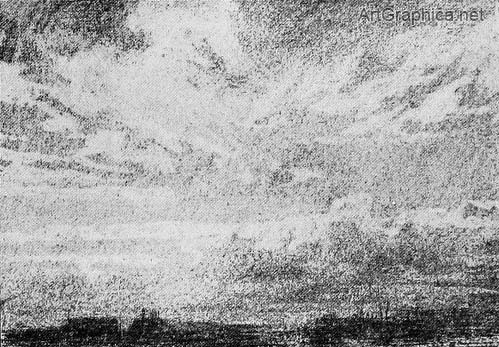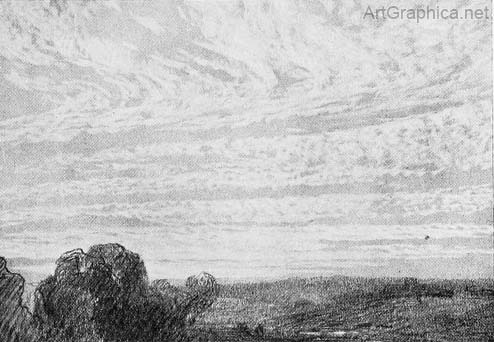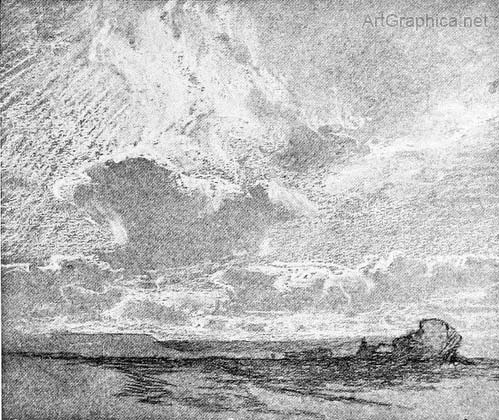Sky in Perspective |
||||||||||||||||
|
Page 14 / 25
 CHAPTER XIII PERSPECTIVE OF THE SKY AND SEAPERSPECTIVE of the Sky. — The wonder and delight we experience in looking at the sky need not be less, or its forms appear in a matter-of-fact light, by reason of our enquiring into the laws that govern its exquisite, embellishment. Cumuli. — We cannot look at the massed cumuli of thunder-forms without feeling their power and dignity, but we gain facility in drawing them, if the foreshortening of their serried ranks is familiar to us. The regular lessening in the width and depth of receding shapes ; the overlapping of nearer contours ; the reduction in size of more distant forms ; have all been the subject of former exercises. These should not be overlooked, because the scenery of the sky has so many other powers of attraction. Cirrus clouds. — In wisps of the upper sky ruled by the winds we find every form that fantasy can suggest. On one day drawn-out lines span the whole vault overhead, each line steering to a meeting- point straight ahead of us. If we " about turn " we see the phenomenon repeated, for the other end of the lines meet again at another point opposite the first. Stand in the centre of a long building and look along the roof —its lengthways timbers steer to a V.P. at one end ; turn your back on it, and the timbers tend to a V.P. at the other end. It is the same rule for the mechanical boards as for these delicate strands of vapour. This statement must not be taken quite literally because the V.P. for the receding lines of the building would be on the horizon. The V.P. for the lines of clouds would be far below the horizon because the clouds are, as it were, the underside of a semicircular ceiling. On another day curved wisps are arranged in groups ; each wisp in a group radiating from the vanishing point for that group. It often happens that in the upper group the wisps radiate upwards from a vanishing point below. Another group to one side and lower, carries its wisps more horizontally, so that they radiate from a vanishing point under that of the upper group. A third and still lower group takes a more horizontal position. In this manner the radiating ends of all the groups are arranged on a curved line. Another day finds the wisps in horizontal rows ; each more distant row seeming to be narrower in regular sequence. Each wisp in the row filled, as it were, by the wind and bellying from it ; its tail recurved by a current from the opposite quarter. This double curve, beautiful in itself, is subject to those changes that our view of it affords. In the upper row overhead—almost an S in shape — it becomes flatter in each receding row, till nearing the horizon it hardly differs from a horizontal line. Away on either side the ' curves become more and more lengthened.
Cirro-stratus. — Dappled cloud patterns of a more fleecy character than the " mare's tails " present somewhat similar effects. The curved wisps we mentioned may be thought of as imaginary side edgings for numberless detached or semi-detached fleeces lying between them at right angles. The group arrangement holds good, and sometimes becomes more intricately beautiful from the crossing of groups brought into position by cross-currents. The countryman, always ready to find a telling and often pleasing name for Nature's subjects, has dubbed some forms of mottled skies with the nicknames " mackerel-back," " Mother Carey's chickens," " hen-scratted." Ruskin aptly likens them to sea-sand ribbed by the tide ; the scientist coldly labels them cirro-stratus. Whatever you call them, remember they are made up on a system, not haphazard ; that curved lines varied by our perspective view underlie their arrangement ; and that in their component parts, and as a whole, they tell which way the wind blows.
Stratus. — The perspective of the lower region is of the simplest kind and may be likened to a boarded ceiling ; our view being across the boards. As, however, these long horizontal stretches of cloud are impressive by the repetition of their lines, one must render the full extent of their receding surface by the gradual reduction in their depth. Near the horizon the closeness of their dividing edges must be carefully observed. In painting a corresponding perspective of the brush strokes may assist the impression of distance. Other clouds less regular in order — more cross-bred in character make fine groupings. Here again the foreshortening of surfaces and spaces between is all-important. Their massing in the horizon and detachment overhead—the breaking away of units from collective groups—their tendency to radiate from certain points—are matters all concerned with simple perspective laws that cannot be neglected.
The perspective of smoke. — It is worth notice that lines of smoke (say from a row of chimneys or a line of ships) though really travelling with the wind in parallel lines appear to tend to a distant point. That is only an example of our first rule. But one has met people disturbed by this apparent incongruity when they looked out to:sea instead of overhead to find which way the wind lay. Curvature of the earth. — Looking down from the hill-top on to the land below, the nearer fields appear to slope upwards as if we should have a slight incline to traverse before we reached the distant plain. The middle distance appears to lie more level—the far distance quite so. In pictures we represent all this as one level plain stretching to the horizon.' We do so because this is how people think of it, and it adds nothing to the beauty of Nature to make it otherwise. If we were recorders of facts and science only, we should use horizontal lines on which to place our vanishing points for each surface, one line for the foreground, another for the distance, and a third for the far distance, and by this means could convey the impression of the rotundity of the earth. In painting the sea we cannot neglect this curvature, for has not even the tripper to Clacton learnt to say " hull down " when speaking of a ship sailing behind the visible horizon[1] We have to reckon with this " of the sea ; for its most distant visible surface is below our horizon line,•and ships in our picture if continued to it would rest on a cushion of air instead of floating on the sea. In Nature we see the hull of a ship appearing to rise more and more out of the water as she nears the horizon. It sits as it were on the edge of the water silhouetted against the sky. After this the hull sinks and sinks behind the sea-line till only a mast-head or line of smoke betrays her existence. Standing on a cliff we can clearly observe this surface curve from the shore to the open sea. In practice, then, we use a horizon line above the sea surface for the V.P.'s of our foreground sea, the sea-level as an horizon for the most distant strip, and if necessary a lower horizon for all that lies beyond. Above all we remember we are drawing a surface that might vulgarly be likened to the outside of a huge cylinder. If instead of a cylinder I had said " convex surface " I might have implied that the curvature from left to right had also to be considered, but this (as explained in the introductory chapter) is not the case. A six-foot man standing on the sea-level cannot see its surface beyond three miles away, and he would have to be twenty feet above sea-level before he could see five miles. Visibility of distant objects. — In a nautical almanac I find this table (abbreviated) of the distances of objects seen at sea. In using it, you first reckon the distance visible according to the height of your eye above sea-level ; then the distance that would be visible from the height of the object ; then add the two together. I add a diagram to complete the explanation. 1. Not quite. We ought to take our foreground to a V.P. a bit above the visible horizon, and to flatten the far distance as if its plane ended at a line below the horizon. 
Example. — A man 5 ft. above sea-level can see only for 2'57 miles. At 100 ft. above sea-level he would see 11.50 miles. Therefore the actual distance of the object 100 ft. high that he can see is 14.07 nautical miles from him. The curve of the sea is also appreciable when looking along the shore rim ; the lines of the breakers —unless our view is a very low one—tend to a V.P. well above its distant surface. Foreshortened surfaces. — One would be but dull-witted to miss the chance of foreshortening waves by means of the lines, curves, and circles of the spume. It explains the flatness or upheaval of a plane just as the decoration on a jar helps to explain its roundness, or the pattern of a dress the shape of a figure. Men who have painted the sea and impressed us with the feeling of its restless heave, and weight of water, have done this, not by their intimate knowledge of its form alone, but by an understanding of that subtle perspective we call foreshortening ; Turner, Henry Moore, Julius Olsson, each in his own way, show us its grandeur. We cannot take their pictures line by line to show how each had its meaning, but it must be looked for in pictures and in Nature. The truth that distinguishes all good art is attained only by the hand working under two forces simultaneously—the observation of natural laws and beauty, and the almost unconscious reasoning that selects the right forms ; and so the mind of the artist is added to that which he paints.
Next Page
Water Reflections Prev Page Domes, Turrets and Steeples
|
||||||||||||||||











